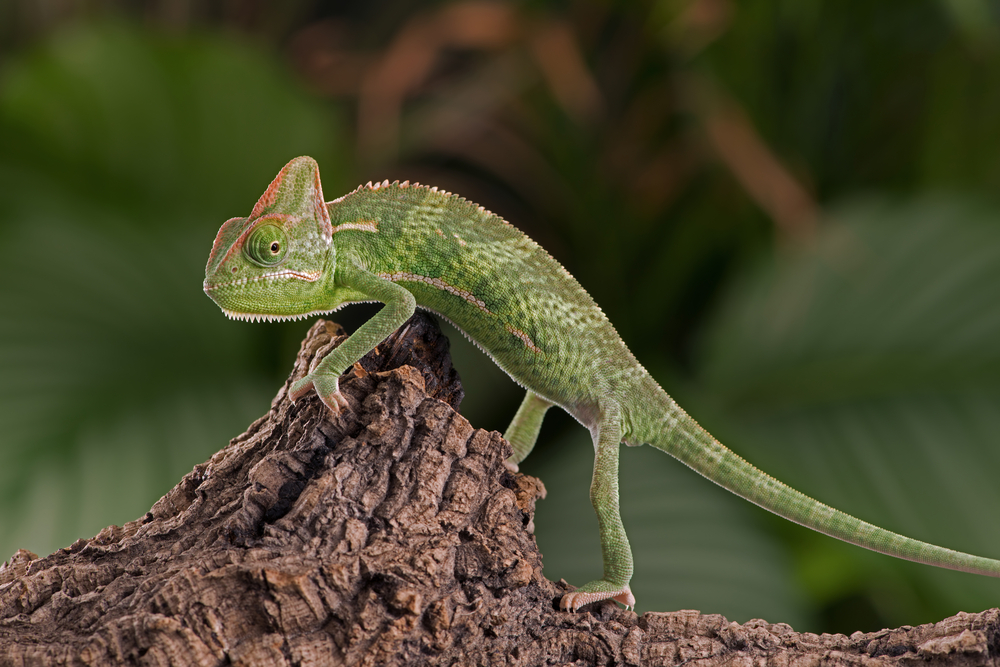Veiled chameleon, you may never hear about it before. This chameleon dominated with green color but not as light as chameleon garden. Their green color usually combined with yellow, and some of them have tosca vibe green. The veiled chameleon is an endemic lizard from Arabian Peninsula in Yemen and Saudi Arabia. Beside called as veiled chameleon, this species also known as cone-head chameleon and Yemen chameleon.
Why they called cone-head chameleon? Well it is related with their physic which has like helmet above their head. If another chameleon has like spike around the back, veiled chameleon only had it in the head. The spike of veiled chameleon is placed under their jaw so from far if you look over their shape, their head is like triangle. On the back, there is still spike but not intense as under their jaw. Their tailed also really rolled which is really beautiful. And their body tends to be rounded. It’s like they are bowing.
Specifically if we talk about appearance, there are some differences on male and female veiled chameleon. The male have higher veiled than female, physically their head is more precise and bigger than female. The male have tarsal spur on every each their legs and the female didn’t. When they are getting older, both male and female is changing in different color. And generally the male is larger than female. The adult size of veiled chameleon depends on their gender.
Usually the male growth until 43.2-61 centimeters from the tip of the snout the end of their tails and the females will growth until 25.4-33 centimeters. And the weight, male is usually 85-170 grams and the female is 85-118 grams. Those number before can be increase depend on your treatment and food type that you give for them.
Like another kind of chameleon, as psychologically they are same which hate to be touched in their back, love to live lonely, and need calm environment. Mostly of them have short lifespan which is just 5 years old but the male able to living until 8 years as long as they get well treatment.
Basically, breed veiled chameleon is not far different when raise another chameleon. Fortunately they breed by laying eggs. As we know that some kinds of chameleon breed by laying eggs and give birth so it needs different method to help them. Back to the topic, here are some steps to breed veiled chameleon.

- Color changing and another physically transforms.
As we know that chameleon will change their color during sick, stressed, pressed, or cold. But they do change their color during pregnancy. For the veiled chameleon you can found them transform into ‘pale’ color. For example if you have green the female veiled chameleon which has grey vibe, she will transform into cream color and their green will mostly disappeared and dominated with chocolate or brown. You may little bit shocked and guess that your chameleon is sick or stress after sex thing but that’s totally not true.
They do may feel stressed because this chameleon species loves hard sex style but every creature will feel differences during pregnant, isn’t it? So it is not because they feel forced and stressed but it is like representation of their adjustment to prepare as mom. Their back also will change. If it is like curved before the female is pregnant, that curved back will disappeared and tends to be really straight. And don’t forget, their tummy is bigger too. On this point, all you can do as pet owner is just don’t be shock and just calm. Don’t act too much and avoid the useless reaction which may increase their stress level. The chameleon mama will be back normally after she laid her egg and it doesn’t need a long time.
- Laying eggs process.
Honestly there is two method to breed and lay their eggs and the ways are naturally and imitation. If you choose natural ways, just add some sand into their cage and let them excavated their hole cave to place the eggs. But if you want to more than natural, you can help them and get the veiled chameleon mama in your own incubator. It is so easy to make the incubator by yourself. You just need a huge trashcan and filled the over half with sand, a big branch with vines which wrapped around it and fitted screen over the top. Don’t forget to install UV light and basking lamp. You can cover your own incubator using wire. Don’t forget to measure the temperature and the humidity and placed food and drinking water inside it.
Honestly it is similarly called as place breeding than incubator but that’s okay because the imitation incubator is similarly with that but has different cover. During digging process which is means the laying eggs is getting near, the chameleon mama will not eat or drink. She may too focus to lay the eggs. This digging process takes some days, usually for 4-7 days. Even need extra energy to do that, chameleon mama tend to need more water than food. Ah almost forgot, the eggs appearance is really white which looks like rambutan fruit seed. Chameleon mama can produces until 30 eggs per lay. The eggs texture is slimly. The slimly is used for paste the egg over the nest in their wild life.
- Incubate and wrecked process
In their wild life, veiled chameleon will used the heat sand in Arab to incubate her eggs. But don’t worry you can make your own incubator as mentioned before. To make the heat is not coming out you can use the trashcan cover to cover up your own incubator. It will take 190 days until they started to hatching out. Keep the dampness of the incubator into medium to make sure that it wasn’t drying out.
For wrecked process itself, it takes about a week and each one took around 24 hours. Not 100% the eggs can live. Five from 30 eggs usually dies. The newborn veiled chameleon eating fruit lies and after a view days they start to drink water. For giving water, you can spray it over the wall and leaves on the plants which you inside it before. To make their growth become quick, you can give them calcium supplement beside they are still young and can’t hunt perfectly yet. For temporary situation, you can place the babies veiled chameleon into one cage but remember separate it into different cage when they are getting adult.
If you feel hard to raise the 26 veiled chameleons together, you can let them to be adopted, sell it, or give it into biology student collage as research object. Raise it in dozen will takes big budget. If you have fit budget which able to cover up their treatment, you can go ahead with it. But if you don’t have enough budget, don’t do it.

